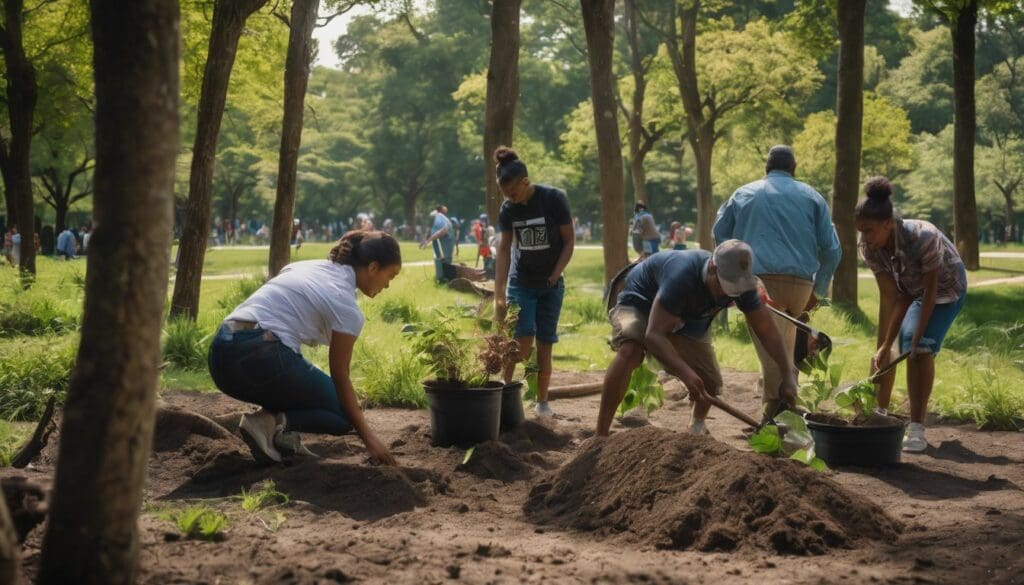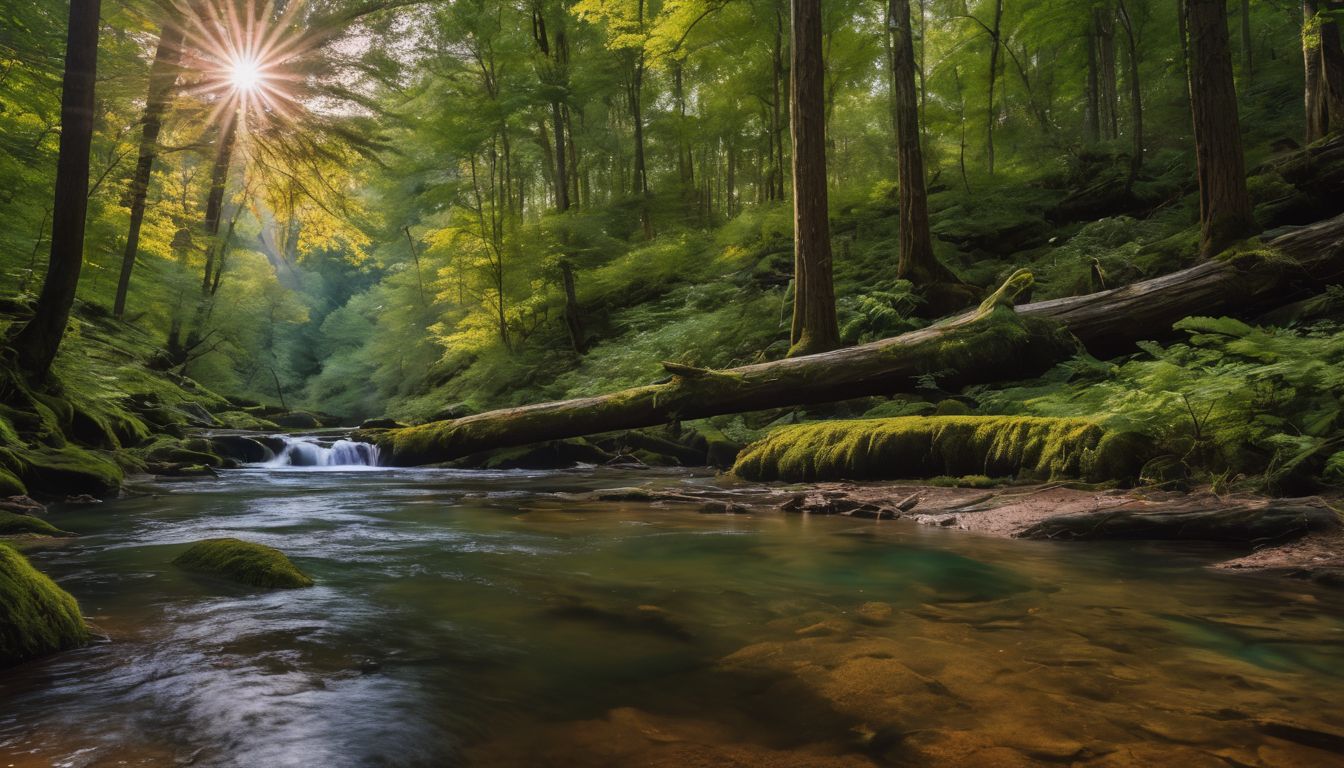Ever had that burning desire to stand up for our precious green patches, but found yourself at sixes and sevens on how to begin? We know the feeling all too well. It was the sight of our own cherished parks and fields facing peril that spurred us into action.
The fruit of our labour is a comprehensive, easy-to-follow guide designed to rally you and your neighbours in setting up a grassroots environmental advocacy group. Join us as we roll up our sleeves and get stuck in – together we’ll make waves!
Key Takeaways
- To start an environmental advocacy group, define your mission and vision to guide your actions and attract members who share the same passion for protecting the environment.
- Research successful groups, conduct due diligence, build community connections, and secure funding sources for a strong foundation to support your initiatives.
- Focus on creating a clear organisational structure with designated roles and responsibilities; this ensures efficiency and accountability within the group.
- Choose an engaging name and create a symbolic logo that reflects your environmental mission to establish identity and encourage wider participation.
- Emphasise inclusivity by involving diverse community members in decision-making processes; this enriches discussions, broadens perspectives, and strengthens the group’s effectiveness.
Understanding Advocacy Groups
Advocacy groups are vital in driving change and raising awareness for environmental issues. Through grassroots efforts, these groups can mobilise the community to take action and hold decision-makers accountable.
Defining the concept
To set things in motion, we need to grasp what an environmental advocacy group truly is. It’s a team of passionate individuals who band together to promote conservation and protect our planet.
We strive for sustainability, using our collective voice to push for policies and practices that back up climate action and ecological advocacy.
Our aim as environmental advocates is simple yet profound: ensuring a liveable planet for generations to come. Through community engagement, we champion green movements and foster awareness about the importance of sustainable living.
Now let’s look at why these citizen advocacy groups are not just helpful but necessary in today’s world.
Importance and need for citizen advocacy groups
Advocacy groups play a crucial role in addressing environmental issues at the local level. These organisations provide a platform for citizens to come together, voice their concerns, and actively work towards sustainable solutions.
By forming citizen advocacy groups, we can ensure that our community’s environmental priorities are heard and acted upon by decision-makers.
Citizen advocacy groups also serve as an essential channel for educating and engaging the public on critical environmental issues. By advocating for sustainable practices and championing conservation efforts, these groups can inspire widespread support for environmentally friendly initiatives.
Preparing to Create an Advocacy Group
Before setting up your local environmental advocacy group, it’s important to do your research and due diligence. Building connections with like-minded individuals and securing funds will also be crucial in laying the groundwork for success.
Researching best practices
Before starting a local environmental advocacy group, it’s crucial to research best practices within the field. Investigating successful advocacy groups can provide valuable insights into effective strategies for community engagement and environmental impact.
By studying existing models, we can learn from their experiences, identify potential pitfalls to avoid, and gather practical tips for building a strong and sustainable organisation.
This knowledge will help us lay a solid foundation for our group and increase our chances of making a meaningful difference in our community’s environmental conservation efforts.
In our pursuit of excellence, we must explore successful examples within the realm of grassroots environmental activism, gathering inspiration and ideas that align with our vision.
Doing due diligence
Once we have thoroughly researched best practices, the next step is to do our due diligence. This involves carefully assessing and evaluating all potential risks and opportunities before moving forward with forming our advocacy group.
We must conduct thorough research on environmental issues in our local community, analyse existing advocacy groups, study successful conservation projects, and identify any legal or financial considerations that may affect our work.
Conducting due diligence will help us make well-informed decisions as we lay the groundwork for our environmental advocacy group. By taking this proactive approach, we can ensure that we are well-prepared to address any challenges while maximising the impact of our efforts in championing environmental conservation within our community.
Building connections
To effectively create our local environmental advocacy group, we must prioritise building connections. Engaging with community stakeholders and like-minded organisations is crucial for raising awareness and garnering support for our cause.
By establishing strong relationships, we can collaborate on initiatives, share resources, and amplify our impact in advocating for a healthy planet. We should actively seek out partnerships with educational institutions, local businesses, and other environmental groups to build a network that will strengthen our efforts.
In addition to connecting with external parties, fostering internal connections within the advocacy group is equally important. Open communication and mutual respect among members are essential for maintaining motivation and teamwork.
Securing funds
To effectively advocate for environmental causes and foster community engagement, securing funds is essential. This involves identifying potential sources of financial support such as grants, crowdfunding, sponsorships from local businesses or organisations, and individual donations.
Engaging with stakeholders who share your passion for environmental conservation can also lead to collaborative funding opportunities. By actively seeking out these financial resources, our advocacy group can fuel meaningful projects that make a tangible impact on the local environment.
By diversifying our approach to securing funds through various channels and building strong partnerships within the community, we can ensure sustainable support for our initiatives in advocating for a healthier planet.
Building Your Group
Once you’ve done your due diligence and secured funds, it’s time to establish a strong core team and recruit members who are passionate about environmental advocacy. Read on to learn more about creating a local environmental advocacy group!
Establishing a strong core team
We assemble a capable team committed to our cause. We recruit individuals equipped with diverse skills and expertise. Each member shares our vision and values, adding strength to the core team.
Our collective efforts drive the group forward towards achieving environmental goals.
Recruiting members and non-members
To grow our advocacy group, we must actively recruit members and non-members who are passionate about environmental causes and willing to contribute. Here’s a step-by-step process for effective recruitment:
- Identify potential members: Seek out individuals in your community who have shown an interest in environmental issues, conservation efforts, or social responsibility.
- Spread the word: Utilise social media platforms, community notice boards, and local events to raise awareness about your advocacy group and attract people who share our values.
- Host informational sessions: Organise gatherings to inform interested individuals about the group’s mission, goals, and how they can get involved.
- Collaborate with other organisations: Partner with existing environmental groups, schools, or businesses to reach a wider audience and tap into their networks.
- Provide opportunities for involvement: Offer various ways for members to engage with the group based on their availability and skills, such as event planning, outreach campaigns, or research projects.
- Foster inclusivity: Ensure that your recruitment efforts consider diversity and inclusion to create a welcoming environment for all individuals who want to participate in environmental advocacy efforts.
- Establish clear communication channels: Keep everyone engaged by maintaining open lines of communication through regular updates, newsletters, and feedback mechanisms.
Setting Your Group’s Goals and Responsibilities
We will discuss the importance of creating a clear vision and mission statement, choosing a group name and logo, establishing an organisational structure, involving the community, and addressing diversity in our environmental advocacy group.
Learn how to build a strong foundation for your group’s success. Read more about it in our blog post!
Creating a vision and mission statement
Setting a clear vision and mission statement is crucial to provide focus and direction for our local environmental advocacy group. Our vision should articulate the future we envision for our community and the planet, inspiring others to join us in making it a reality.
It’s about painting a picture of what success looks like and why it matters to us all. Meanwhile, the mission statement outlines what we aim to achieve and how we plan to do it. It serves as our guiding light, ensuring that every action aligns with our purpose of protecting the environment.
Crafting these statements requires input from everyone involved – they must resonate deeply with each member while also being easily understood by those outside the group. Ultimately, they will define who we are and what we stand for, providing clarity to potential members, partners, funders, and stakeholders alike.
Choosing a group name and logo
After creating a vision and mission statement, the next step is choosing a group name and logo that truly represent your local environmental advocacy organisation. The group name should be clear, memorable, and reflective of your goals.
Consider incorporating words related to nature, conservation, or community action. As for the logo, it should visually convey the essence of your group’s mission. It could incorporate elements such as trees, animals, or sustainable symbols to resonate with environmentally conscious individuals in your community.
When selecting a group name and designing a logo, consider involving members from diverse backgrounds to ensure inclusivity and representation within your organisation. A well-chosen name and distinctive logo will help establish your identity and attract potential supporters who share your passion for environmental causes.
Organisational structure
After settling on a group name and logo, it’s crucial to establish a clear organisational structure for our advocacy group. This involves designating roles and responsibilities within the team, determining decision-making processes, and creating communication channels.
By having a well-defined structure in place, we can ensure efficiency, accountability, and effective coordination among members. Moreover, involving the community in this process can help address diversity and inclusion within the organisation, ensuring that all voices are heard and represented.
In doing so, we create a strong foundation for our environmental advocacy group to thrive and make a real impact in our local area.
Involving the community and addressing diversity
Engaging the community is crucial; it fosters shared responsibility and empowers everyone involved. Actively seeking diverse voices ensures a comprehensive representation of perspectives, enriching discussions and decisions.
To increase involvement, consider hosting open forums, conducting surveys, or collaborating with local schools and businesses to expand outreach efforts. When organising events or campaigns, make sure to incorporate inclusive language and create accessible spaces to encourage participation from all demographics.
By valuing diversity in your advocacy group’s membership and activities, you not only promote inclusivity but also gain a wider range of ideas and solutions regarding environmental concerns.
Conclusion
In conclusion, starting a local environmental advocacy group is an impactful way to contribute to positive change. You can form connections, secure funds and recruit members with dedicated effort.
Setting clear goals and responsibilities will bring your vision to life, engaging the community and addressing diversity for a more inclusive approach.
FAQs
1. How do I start a community environmental group?
To create a local environmental advocacy group, gather like-minded individuals, educate yourselves on key issues, and organise as a citizen advocacy organisation focused on civic engagement for environmental causes.
2. What should our new environmental group focus on?
Focus your grassroots advocacy on taking action for a healthy planet by promoting environmental education and involving stakeholder groups in your area to address local concerns.
3. Why is it important to have an environmental advocacy group in my community?
Forming an environmental advocacy organisation can lead to positive changes at the local level by uniting people to protect and improve their natural surroundings through community organising.
4. Who should be involved in setting up the local environmental group?
Engage with various members of the community, from students to professionals, ensuring diverse perspectives are included when starting your grassroots advocacy and working towards common goals together.





